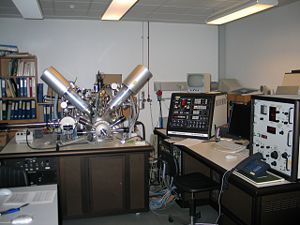Specific Process Knowledge/Characterization/SIMS: Secondary Ion Mass Spectrometry: Difference between revisions
No edit summary |
|||
| Line 63: | Line 63: | ||
|} | |} | ||
Revision as of 11:37, 31 August 2015
Feedback to this page: click here
Atomika SIMS

The Atomika SIMS analyses the composition of a sample by secondary ion mass spectroscopy. By using either oxygen or cesium ions accelerated by a high tension the surface of the sample is sputtered off as ions. These ions are analysed in a mass spectrometer and one can determine the elemental composition as a function of depth. If compared to signals from reference materials one can quantify the atomic composition - in certain cases down to extremely low concentrations (ppm). Doping levels and impurities may be determined.
Please note that no user will be instructed on the SIMS. Danchip staff will run your samples.
The user manual and technical information and contact information can be found in LabManager:
The Atomika SIMS in Labmanager
An overview of the performance of the SIMS
| Purpose | Determination of atomic composition |
|
|---|---|---|
| Performance | Measurement accuracy depends on |
|
| Process parameters | Ion gun parameters |
|
| Mass spectrometer parameters |
| |
| Sample position |
| |
| Sample requirements | Substrate material allowed |
|
| Substrate size |
| |
| Batch size |
|
